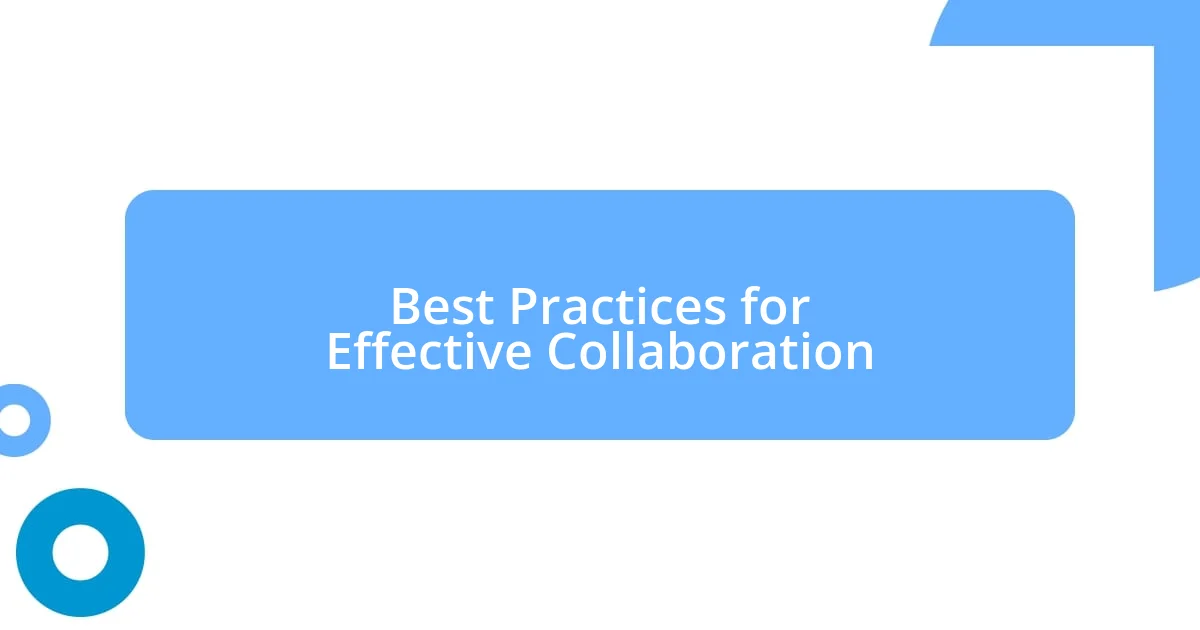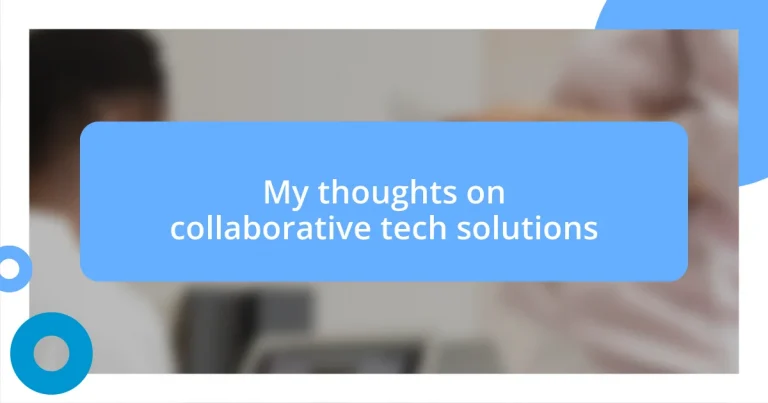Key takeaways:
- Collaborative technology enhances team dynamics by fostering real-time communication, centralizing resources, and promoting inclusivity, thereby boosting creativity and productivity.
- Key features such as task assignment, seamless integration, user-friendly interfaces, and version control significantly improve collaboration and accountability among team members.
- Challenges in implementing collaborative tools include resistance to change, varying tech-savviness among team members, and maintaining effective communication, which require best practices like clear communication and feedback loops to overcome.

Importance of Collaborative Technology
Collaborative technology has become a lifeline for teams, especially in today’s fast-paced work environment. I remember a project where my team was split across different locations. We relied on collaborative tools to share ideas and feedback in real time, and it was powerful to see how our creativity flourished despite the physical distance. Isn’t it amazing how technology can bridge gaps that would have seemed insurmountable just a few years ago?
Moreover, these tools not only streamline communication but also foster a sense of community. I’ll never forget how we celebrated small wins during our virtual meetings, reinforcing our connections and boosting morale. This sense of belonging is vital—don’t you think? Without it, collaboration can feel hollow and disengaged.
Finally, innovative collaborative technology enhances productivity by facilitating better organization. I once struggled to keep track of tasks and deadlines until we adopted a project management tool; the shift was transformative. It made me realize that when everyone has clarity on their roles and responsibilities, the whole team thrives. How do you think your own productivity would change with the right tech solutions in place?

Benefits of Using Collaborative Solutions
Collaborative solutions bring a wealth of benefits that can significantly enhance team dynamics. One remarkable aspect I’ve noticed is how they foster real-time communication. I remember a time when I felt isolated working on a group project. Once we adopted a shared platform, chatting about ideas became effortless. The immediate feedback transformed our collaboration and turned brainstorming sessions into vibrant discussions. Don’t you find it empowering when you feel heard right away?
Another key advantage is the ability to centralize resources. I once lost track of multiple documents spread across emails, drives, and chats. It was frustrating! However, once we integrated a collaborative workspace, all the essential materials were in one place. This not only saved time but also elevated our decision-making process since everyone had easy access to the same information. Have you ever felt the overwhelming chaos of misplaced files?
Lastly, collaborative technology promotes inclusivity. I participated in a project with diverse voices, and it felt enriching. Everyone had a chance to contribute, regardless of their location. It was impactful to witness ideas from across the globe blending together. This diversity sparked creativity like I’d never experienced before, and I’ve come to cherish the different perspectives that collaborative solutions invite. How do you see your own ideas thriving in a more inclusive environment?
| Benefit | Description |
|---|---|
| Real-Time Communication | Fosters immediate feedback and vibrant discussions. |
| Resource Centralization | Simplifies access to materials, enhancing decision-making. |
| Inclusivity | Encourages diverse contributions, sparking creativity. |

Key Features of Collaborative Tools
When it comes to collaborative tools, several key features stand out to me as game changers in enhancing teamwork. One time, I found myself juggling multiple projects, and the need for task tracking became evident. With tools that offer task assignments and progress tracking, I could finally breathe easy, knowing that everyone was on the same page. It’s incredible how such a feature can reduce stress levels and foster accountability within the team.
Here are some of the key features that I’ve found indispensable in collaborative tools:
- Task Assignment and Tracking: Easily assign tasks to team members and monitor progress in real time, ensuring accountability.
- Integration with Other Tools: Seamless integration with calendars, email, and cloud storage can streamline workflows and enhance efficiency.
- User-Friendly Interface: An intuitive design encourages team members to adopt the tool quickly and minimizes the learning curve, boosting productivity.
- Version Control: This feature allows users to track changes in documents, making it easier to collaborate without the fear of losing important edits.
The emotional impact of having these features is substantial. During one team project, we utilized a collaborative document that everyone could edit together. I remember feeling a rush of energy as ideas flowed and transformed. The version control allowed us to keep everything organized and ensure that no brilliant suggestion was lost. It felt like we were crafting a masterpiece together—everyone contributing their unique strokes to a canvas that was ever-evolving. What features have you found invigorating in your own collaborative experiences?

Challenges in Implementing Collaboration
One of the main challenges in implementing collaborative solutions is resistance to change. I recall a time when my team was introduced to a new tool, and there was quite a bit of pushback. Some colleagues were comfortable with their old habits and felt overwhelmed by the prospect of learning something new. It’s frustrating when enthusiasm for innovation is met with apprehension, isn’t it? Encouraging a shift in mindset often requires patience and ongoing support.
Another significant obstacle is ensuring that all team members are on the same technological level. There have been instances in my experience where varying degrees of tech-savviness created a noticeable gap in participation. Some team members thrived with digital tools, while others struggled just to navigate the platform. This disparity can lead to feelings of exclusion and can stall productive collaboration. How do you foster an environment where everyone feels comfortable contributing?
Lastly, maintaining effective communication within collaborative platforms can be tricky. I remember a project where discussions got lost among endless threads, making it easy for crucial information to slip through the cracks. It was a bit chaotic, and keeping everyone aligned felt like an uphill battle. When the tools meant to enhance collaboration instead lead to confusion, it raises the question: what strategies can we adopt to streamline communication and keep everyone engaged? Finding the right balance is key to overcoming this challenge.

Best Practices for Effective Collaboration
When it comes to fostering effective collaboration, clear communication stands out as a non-negotiable ingredient. I’ve seen teams struggle with misunderstandings simply because they didn’t utilize the chat features effectively in their tools. Implementing regular check-ins—whether weekly touchpoints or daily stand-ups—can create a rhythm that ensures everyone’s voice is heard. Have you ever noticed how simple conversations can illuminate perspectives that are otherwise overlooked?
Another best practice I highly value is cultivating a culture of inclusivity. During one of my projects, we hosted brainstorming sessions where every team member was encouraged to share their ideas, no matter how outlandish. I vividly remember a quieter colleague proposing a radically different approach, which ultimately became the cornerstone of our solution. When everyone feels empowered to contribute, magic happens. How do you create spaces where ideas can flow freely?
Lastly, leveraging feedback loops is crucial for continuous improvement in collaborative environments. I’ve experienced firsthand how gathering feedback after completing a project can pinpoint what worked well and what didn’t. A particularly transformative moment for me occurred when our team implemented an anonymous feedback survey, bringing to light some underlying tensions we hadn’t addressed. By understanding and acknowledging these issues, we could mend relationships and bolster our teamwork moving forward. What steps do you take to ensure your team learns and grows from every collaboration?

Future Trends in Collaborative Technology
I see a significant shift on the horizon for collaborative technology—artificial intelligence is slowly becoming more integrated into our day-to-day tools. I remember the first time I saw AI suggest edits for collaborative documents; it felt like opening a door to a world where our machines understand our workflows. This kind of technology not only enhances productivity but also allows teams to focus on more strategic thinking rather than getting bogged down by mundane tasks. Doesn’t it make you wonder how much creative potential could be unlocked by removing those barriers?
Another trend that excites me is the rise of virtual reality (VR) and augmented reality (AR) in collaboration. I once participated in a VR meeting, and it was surreal to feel like I was physically in the room with my colleagues, despite being thousands of miles apart. It helped bridge that emotional distance; when you can share a virtual space, it fosters a sense of connection that standard video calls just can’t replicate. Imagine walking through a virtual office together—how might that reshape team dynamics?
Lastly, I believe we will see a greater emphasis on data privacy and security as collaborative tools evolve. In the past, I’ve encountered instances where unclear security protocols raised a lot of worries within my team. When sensitive information is at stake, trust becomes a cornerstone of collaboration. Moving forward, I think teams will prioritize using platforms that protect their data and ensure that there is transparency in how it’s managed. What are your thoughts on balancing innovation with security in the tools we choose?

Personal Experiences and Insights
Collaborative tech solutions have shaped my working style significantly. I remember a project where we adopted a new platform that integrated task management with real-time communication. Initially, the change felt daunting, but soon I realized how much smoother our workflows became. The transparency it fostered not only kept everyone accountable but also gave me a clearer view of our collective progress. Have you ever experienced that sense of shared accomplishment when everyone is on the same page?
I’ve learned the power of collaborative tools during my time in a remote setting. The first time I joined a brainstorming session via a shared digital whiteboard was eye-opening. I was amazed by how visually mapping out our ideas sparked creativity across the team, even when we were miles apart. I felt a sense of camaraderie that almost transcended the physical space between us. Isn’t it fascinating how technology can bring people together in ways we never imagined?
One of my most eye-opening experiences was using an analytics dashboard to track our collaboration metrics. I wasn’t fully aware of how certain behaviors impacted our productivity until we optimized our tool usage based on those insights. Understanding the correlation between our communication styles and project timelines was enlightening. This data-driven approach not only transformed how we collaborated but also fostered a culture of accountability. What a revelation it was to see numbers reflect our efforts—how do you measure success in your collaborative projects?














